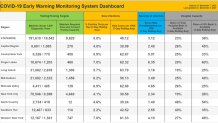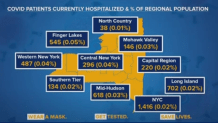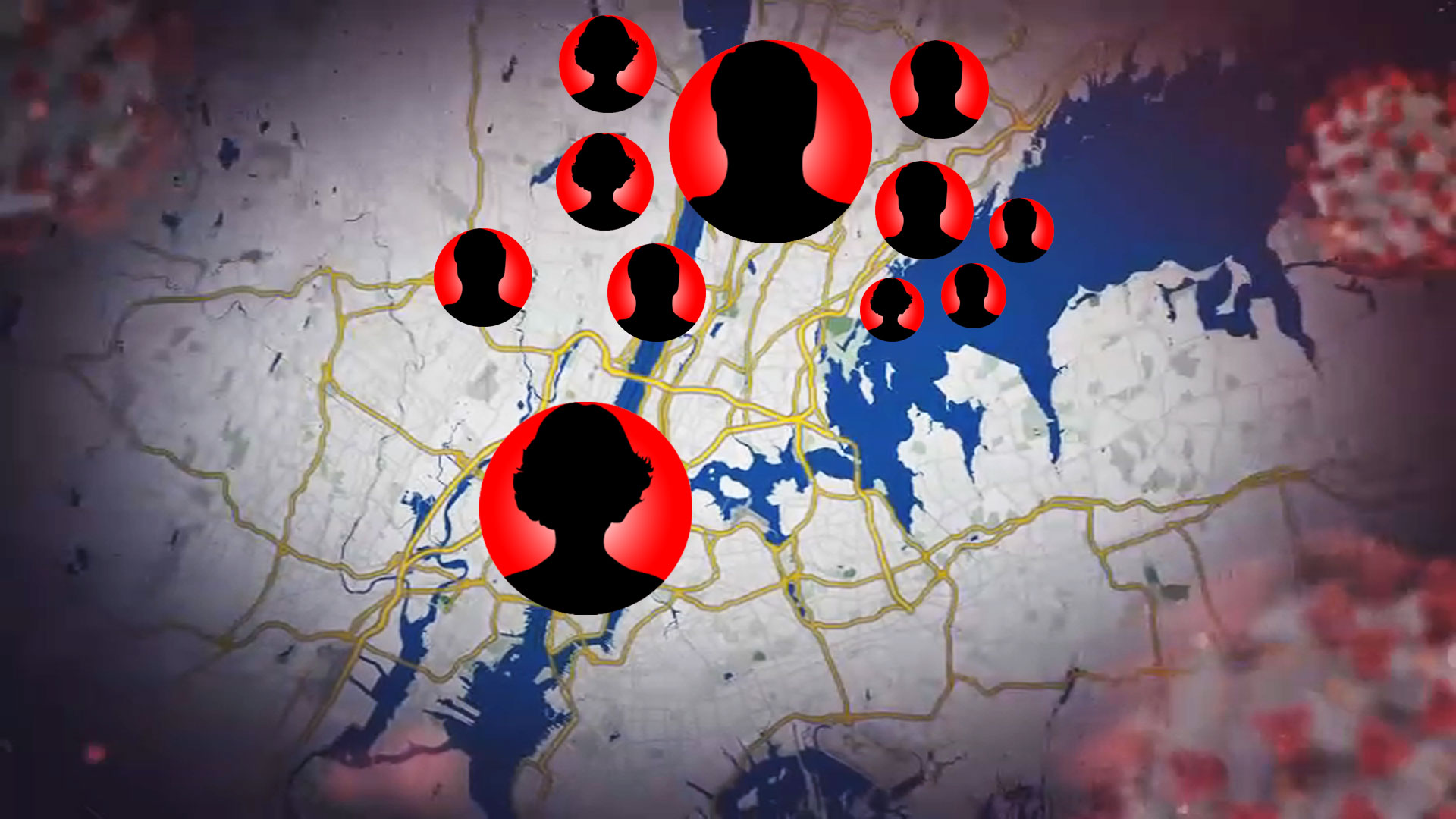What to Know
- If hospitalization capacity is projected to hit 90 percent within three weeks for any of New York state's 10 regions, Gov. Andrew Cuomo says he'll shut it down entirely, including nonessential business
- Dr. Anthony Fauci, who joined Cuomo at his briefing Monday, said he expects the post-holiday effect to fully materialize by mid-January. Without substantial mitigation, he says times could turn really dark
- New Jersey is also seeing an alarming spike, reporting its 2nd highest daily case total Tuesday (5,820) and 90 new deaths; Gov. Murphy says he has no plans to alter indoor dining at this point
New York state is starting to see its daily COVID deaths climb along with an increase in hospitalizations. It reported its highest single-day fatality toll (80) in months Monday as Gov. Andrew Cuomo ordered hospitals to boost bed capacity by 25 percent. If rates keep rising, indoor dining will suffer the consequences first.
More than 4,800 COVID-19 patients are now hospitalized statewide, double the amount reported Nov. 18 and the highest total since May 22. With 19,000 or so admitted at the peak of the crisis in spring, Cuomo said the state isn't yet at a “critical” level of COVID-19 hospitalizations. But the growth rate is worrisome.
For the governor, the bottom line is whether hospitals can handle the increased patient volume until COVID rates start to see vaccination-related reductions. If they can't, and hospitals in a given region appear on track to hit 90 percent of capacity within three weeks, based on a seven-day average, it's shutdown time.
That means all schools, nonessential businesses and restaurant table service in the region in question - a level of lockdown most of the state hasn't seen since spring. No region is close to that yet, though Long Island and New York City are the nearest, with state data showing just 18 percent and 19 percent, of hospital beds open in those respective regions. Cuomo wants at least 30 percent free.

There are some roadblocks along the way to keep hospitalization rates from spiraling to that 90 percent capacity level.
If New York City's hospitalization rate, which is now lower than almost all of the state's other regions, continues to climb from its current level over the next five days, Cuomo will close indoor dining completely citywide for an indefinite period of time, the governor announced Monday. That means indoor dining could be suspended in the five boroughs as early as the rest of the week.
Mayor Bill de Blasio, who warned of additional looming restrictions weeks ago as he sought to mollify frustrated parents about the latest all-remote school switch said when asked about it Tuesday he fully expected closures to come within days.

NYC has a 25 percent-capacity cap for indoor dining, lower than the rest of the state. For other state regions, indoor dining capacity would be lowered to 50 percent or 25 percent if they see hospitalization rates climb for five days. Unlike Mayor Bill de Blasio's controversial positivity rate threshold for closing down schools, Cuomo has no set hospitalization rate trigger mark in this case.
It's simply a matter of avoiding further increase from where regions stand now.
"Stabilization is stabilization," the governor explained. "Where you are now -- stabilize, instead of going up. If your hospitalization rate is 4 percent, instead of going from 4 to 5, you have to stay at 4 and stabilize. Right now it's increasing."
De Blasio started incorporating the city's rolling hospitalization rate per 100,000 residents as of his daily briefing Monday, along with probable COVID cases tied to antigen tests that previously weren't counted along with PCR test results.
As of Tuesday, the city's rolling hospitalization rate was 2.30, up slightly from the previous day and well above the mayor's self-professed 2.00 threshold. De Blasio also reported 2,624 new daily COVID cases, which includes the probable figure. That's more than quadruple the 550 new daily case threshold he set months ago.
Given the stark and continuing increases, de Blasio supports new restrictions, even as he acknowledges the renewed difficulty for struggling business owners.
"This health situation has to be addressed. I do think we're going to see restrictions coming and I think other restrictions have to be on the table so we can be ready to address whatever comes," the mayor said. "We want people to have their livelihoods. But we've got to stop this surge that we're facing."
Daily Percentage of Positive Tests by New York Region
Gov. Andrew Cuomo breaks the state into 10 regions for testing purposes and tracks positivity rates to identify potential hotspots. Here's the latest tracking data by region and for the five boroughs. For the latest county-level results statewide, click here
Source: ny.gov
Cuomo has stressed that new closures were not inevitable, but it'd take a surprising turn of events to ward them off now. He expects the numbers, including the hospitalization rates, to continue to increase between now and mid-January.
So does Dr. Anthony Fauci, who said Monday he expects to see the Thanksgiving surge hit in about 10 days. The Christmas surge will hit 10 to 14 days after that holiday, meaning New York -- and the U.S. as a whole -- likely won't see the total impact from the feared holiday surge until mid-January at the earliest.
Fauci says it can take more than two weeks for hospitalizations to increase following case surges.
New Jersey Gov. Phil Murphy has said his administration plans to carefully review hospitalization statistics in the next week or so to assess any initial post-Thanksgiving increase. Statewide, hospitalizations are at their highest levels since May 14 (3,481 as of Tuesday) and 42 percent of New Jersey's 21 counties reported at least 400 new cases overnight, bringing the total past 377,000.
Daily deaths hit a recent high of 90 Tuesday, though that may reflect a weekend reporting lag in the Garden State.
Unlike Cuomo in New York, Murphy says he has no plans to suspend indoor dining in New Jersey at the moment, though continues to say all options are on the table. He is expected to share the state's COVID various modeling projections during his next scheduled briefing on Wednesday.
Any way you look at it, it appears it's going to be a long month and a half for the U.S. and the states that comprise it. Nationally, total confirmed COVID cases topped 15 million early Tuesday, just days after they surpassed 14 million.
Deaths have soared to more than 2,200 a day on average, matching the frightening peak reached in April, and cases per day have eclipsed 200,000 on average for the first time on record, with the crisis all but certain to get worse because of the fallout from Thanksgiving, Christmas and New Year's.
Worst-case scenario projections from the Institute for Health Metrics and Evaluation predict COVID-19 cases could peak Jan. 20 if states don't reimpose restrictions -- and that the daily tallies could be upwards of 1 million by that time. That model does presume a vaccine rollout beginning in a week or so.
As they await their respective fates -- or for their public's behavior to profoundly alter what now appears to be inevitable -- states and local governments are racing to shore up vaccine distribution plans. Multiple states, including New York and New Jersey, are expected to receive initial doses of Pfizer and Moderna vaccines pending federal emergency use authorization within the next two weeks.
The United Kingdom has already started doling out vaccines and the U.S. government is expected to take up Pfizer's emergency use request Thursday. High-risk U.S. healthcare workers and nursing home staff will get first priority.
Larger-scale distribution to the public is not expected until well into 2021. Mitigation efforts like masks and social distancing may be necessary well beyond that, health experts like Fauci have cautioned. Even with a 95 percent vaccine efficacy rate, some people will get COVID despite getting vaccinated.
Tracking Coronavirus in Tri-State
Cuomo says experts say 75 percent to 85 percent of people need to be vaccinated in order for the economy to return to some semblance of normalcy. That in and of itself is a tall order, given heightened public skepticism of this particular vaccine. According to a new union survey, fewer than half of FDNY firefighters -- first responders who face heightened risk as part of their jobs -- would take the vaccine once it becomes available to them in a few weeks.
There is also disparate skepticism across racial/ethnic and socioeconomic lines, a discrepancy that mirrors the inequitable reality for various communities as it relates to the pandemic overall.



